sensor RENAULT TWINGO 2009 2.G Electrical Equipment - Petrol Injection Repair Manual
[x] Cancel search | Manufacturer: RENAULT, Model Year: 2009, Model line: TWINGO, Model: RENAULT TWINGO 2009 2.GPages: 348
Page 102 of 348
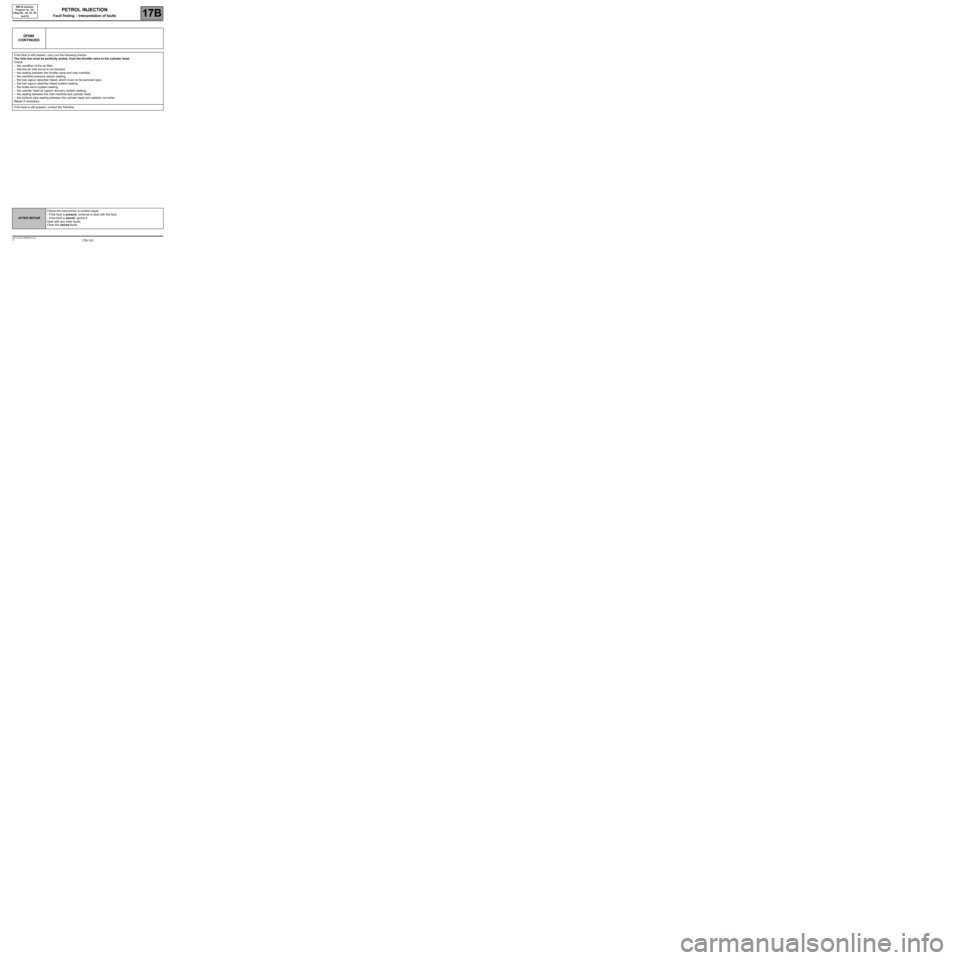
17B-102V7 MR-413-X44-17B000$132.mif
PETROL INJECTION
Fault finding – Interpretation of faults17B
SIM 32 Injection
Program no.: D3
Vdiag No.: 44, 4C, 50
and 54
DF089
CONTINUED
If the fault is still present, carry out the following checks:
The inlet line must be perfectly sealed, from the throttle valve to the cylinder head.
Check:
–the condition of the air filter,
–that the air inlet circuit is not blocked,
–the sealing between the throttle valve and inlet manifold,
–the manifold pressure sensor sealing,
–the fuel vapour absorber bleed, which must not be jammed open,
–the fuel vapour absorber bleed system sealing,
–the brake servo system sealing,
–the cylinder head oil vapour recovery system sealing,
–the sealing between the inlet manifold and cylinder head,
–the exhaust pipe sealing between the cylinder head and catalytic converter.
Repair if necessary.
If the fault is still present, contact the Techline.
AFTER REPAIRFollow the instructions to confirm repair:
- If the fault is present, continue to deal with the fault.
- If the fault is stored, ignore it.
Deal with any other faults.
Clear the stored faults.
Page 104 of 348
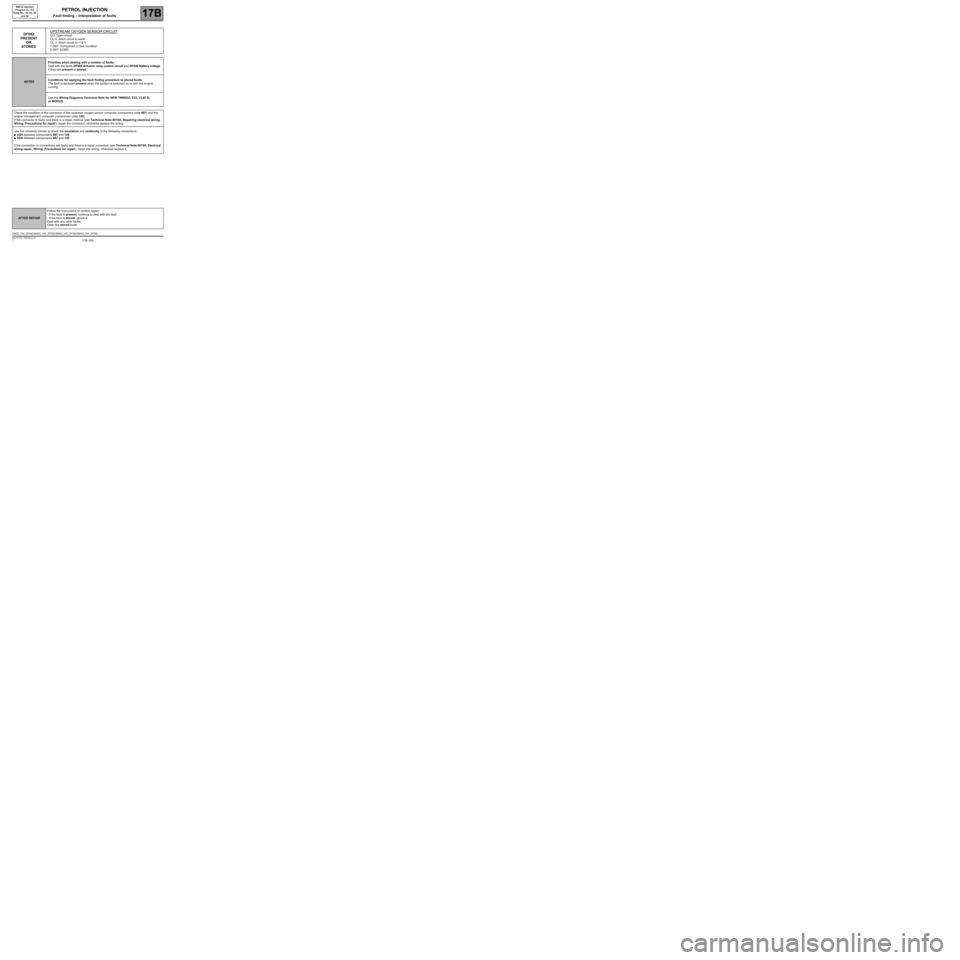
17B-104V7 MR-413-X44-17B000$132.mif
PETROL INJECTION
Fault finding – Interpretation of faults17B
SIM 32 Injection
Program no.: D3
Vdiag No.: 44, 4C, 50
and 54
DF092
PRESENT
OR
STOREDUPSTREAM OXYGEN SENSOR CIRCUITCO: Open circuit
CC.0: Short circuit to earth
CC.1: Short circuit to +12 V
1.DEF: Component in bad condition
2.DEF: EOBD
NOTESPriorities when dealing with a number of faults:
Deal with the faults DF084 Actuator relay control circuit and DF046 Battery voltage
if they are present or stored.
Conditions for applying the fault finding procedure to stored faults:
The fault is declared present when the ignition is switched on or with the engine
running.
Use the Wiring Diagrams Technical Note for NEW TWINGO, E33, CLIO III,
or MODUS.
Check the condition of the connector of the upstream oxygen sensor computer (component code 887) and the
engine management computer (component code 120).
If the connector is faulty and there is a repair method (see Technical Note 6015A, Repairing electrical wiring,
Wiring: Precautions for repair), repair the connector, otherwise replace the wiring.
Use the universal bornier to check the insulation and continuity of the following connections:
●3GH between components 887 and 120,
●3GK between components 887 and 120.
If the connection or connections are faulty and there is a repair procedure (see Technical Note 6015A, Electrical
wiring repair, Wiring: Precautions for repair), repair the wiring, otherwise replace it.
SIM32_V44_DF092/SIM32_V4C_DF092/SIM32_V50_DF092/SIM32_V54_DF092
AFTER REPAIRFollow the instructions to confirm repair:
- If the fault is present, continue to deal with the fault.
- If the fault is stored, ignore it.
Deal with any other faults.
Clear the stored faults.
Page 105 of 348
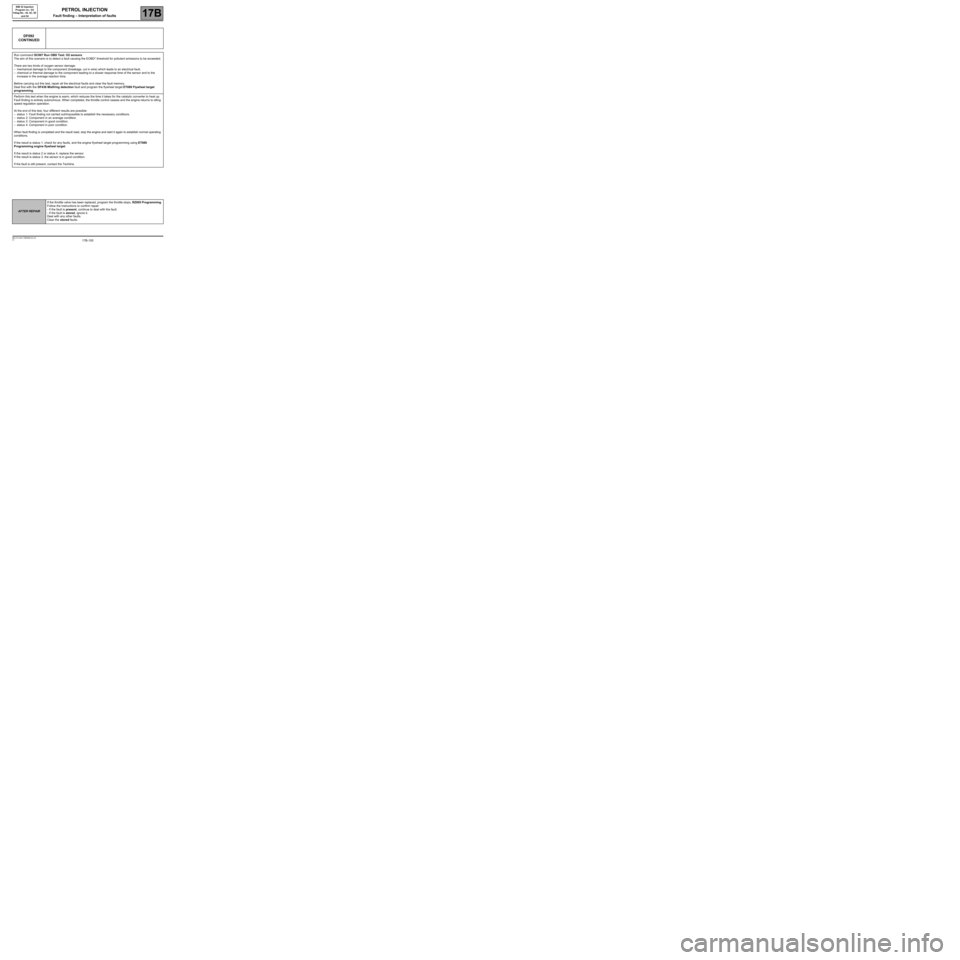
17B-105V7 MR-413-X44-17B000$132.mif
PETROL INJECTION
Fault finding – Interpretation of faults17B
SIM 32 Injection
Program no.: D3
Vdiag No.: 44, 4C, 50
and 54
DF092
CONTINUED
Run command SC007 Run OBD Test: O2 sensors.
The aim of this scenario is to detect a fault causing the EOBD* threshold for pollutant emissions to be exceeded.
There are two kinds of oxygen sensor damage:
–mechanical damage to the component (breakage, cut in wire) which leads to an electrical fault,
–chemical or thermal damage to the component leading to a slower response time of the sensor and to the
increase in the average reaction time.
Before carrying out this test, repair all the electrical faults and clear the fault memory.
Deal first with the DF436 Misfiring detection fault and program the flywheel target ET089 Flywheel target
programming.
Perform this test when the engine is warm, which reduces the time it takes for the catalytic converter to heat up.
Fault finding is entirely autonomous. When completed, the throttle control ceases and the engine returns to idling
speed regulation operation.
At the end of this test, four different results are possible:
–status 1: Fault finding not carried out/impossible to establish the necessary conditions.
–status 2: Component in an average condition.
–status 3: Component in good condition.
–status 4: Component in poor condition.
When fault finding is completed and the result read, stop the engine and start it again to establish normal operating
conditions.
If the result is status 1: check for any faults, and the engine flywheel target programming using ET089
Programming engine flywheel target.
If the result is status 2 or status 4, replace the sensor.
If the result is status 3, the sensor is in good condition.
If the fault is still present, contact the Techline.
AFTER REPAIRIf the throttle valve has been replaced, program the throttle stops, RZ005 Programming.
Follow the instructions to confirm repair:
- If the fault is present, continue to deal with the fault.
- If the fault is stored, ignore it.
Deal with any other faults.
Clear the stored faults.
Page 106 of 348
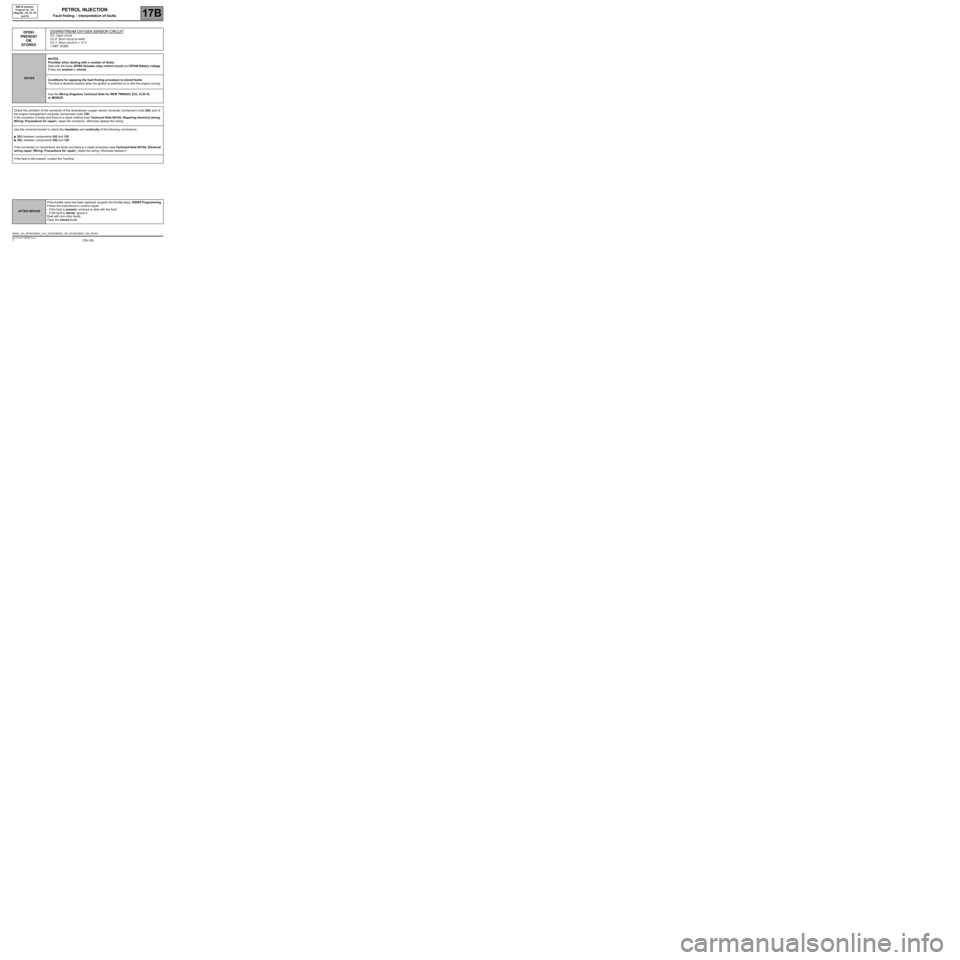
17B-106V7 MR-413-X44-17B000$132.mif
PETROL INJECTION
Fault finding – Interpretation of faults17B
SIM 32 Injection
Program no.: D3
Vdiag No.: 44, 4C, 50
and 54
DF093
PRESENT
OR
STOREDDOWNSTREAM OXYGEN SENSOR CIRCUITCO: Open circuit
CC.0: Short circuit to earth
CC.1: Short circuit to + 12 V
1.DEF: EOBD
NOTESNOTES
Priorities when dealing with a number of faults:
Deal with the faults DF084 Actuator relay control circuit and DF046 Battery voltage
if they are present or stored.
Conditions for applying the fault finding procedure to stored faults:
The fault is declared present when the ignition is switched on or with the engine running.
Use the Wiring Diagrams Technical Note for NEW TWINGO, E33, CLIO III,
or MODUS.
Check the condition of the connector of the downstream oxygen sensor computer (component code 242) and of
the engine management computer (component code 120).
If the connector is faulty and there is a repair method (see Technical Note 6015A, Repairing electrical wiring,
Wiring: Precautions for repair), repair the connector, otherwise replace the wiring.
Use the universal bornier to check the insulation and continuity of the following connections:
●3GJ between components 242 and 120,
●3GL between components 242 and 120.
If the connection or connections are faulty and there is a repair procedure (see Technical Note 6015A, Electrical
wiring repair, Wiring: Precautions for repair), repair the wiring, otherwise replace it.
If the fault is still present, contact the Techline.
SIM32_V44_DF093/SIM32_V4C_DF093/SIM32_V50_DF093/SIM32_V54_DF093
AFTER REPAIRIf the throttle valve has been replaced, program the throttle stops, RZ005 Programming.
Follow the instructions to confirm repair:
- If the fault is present, continue to deal with the fault.
- If the fault is stored, ignore it.
Deal with any other faults.
Clear the stored faults.
Page 107 of 348
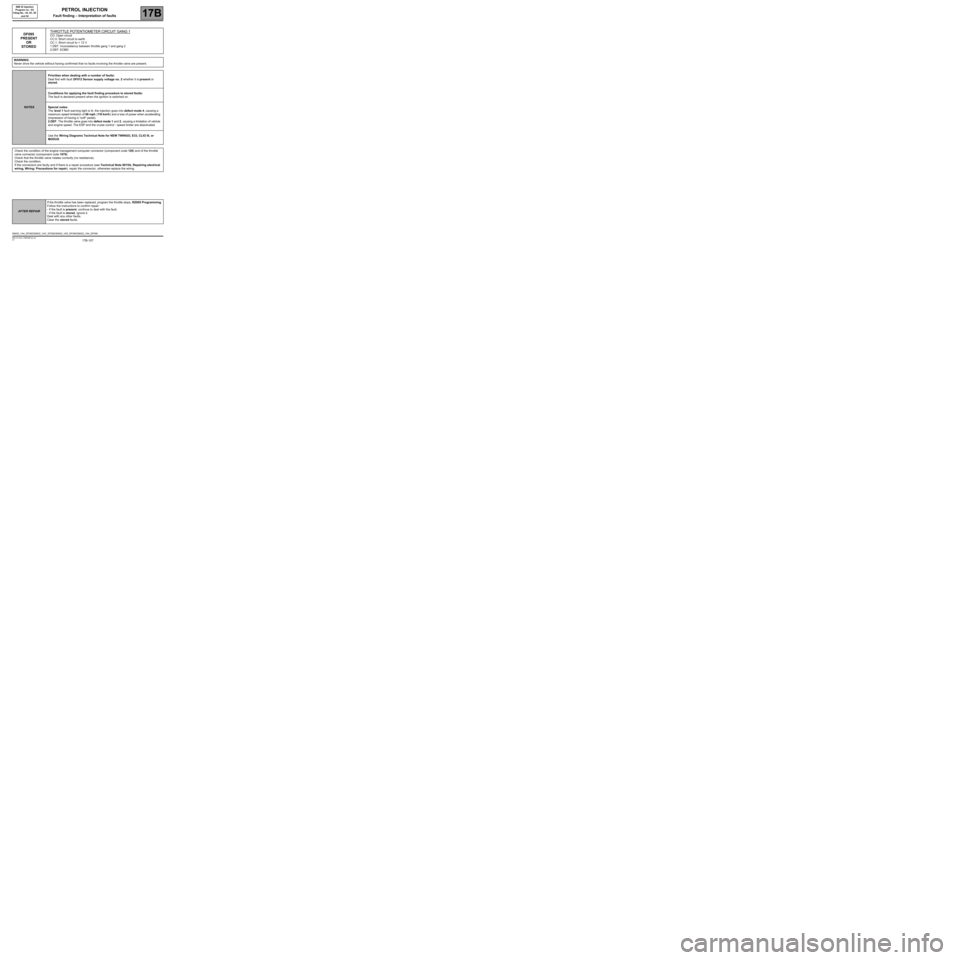
17B-107V7 MR-413-X44-17B000$132.mif
PETROL INJECTION
Fault finding – Interpretation of faults17B
SIM 32 Injection
Program no.: D3
Vdiag No.: 44, 4C, 50
and 54
DF095
PRESENT
OR
STOREDTHROTTLE POTENTIOMETER CIRCUIT GANG 1CO: Open circuit
CC.0: Short circuit to earth
CC.1: Short circuit to + 12 V
1.DEF: Inconsistency between throttle gang 1 and gang 2
2.DEF: EOBD
WARNING:
Never drive the vehicle without having confirmed that no faults involving the throttle valve are present.
NOTESPriorities when dealing with a number of faults:
Deal first with fault DF012 Sensor supply voltage no. 2 whether it is present or
stored.
Conditions for applying the fault finding procedure to stored faults:
The fault is declared present when the ignition is switched on.
Special notes:
The level 1 fault warning light is lit, the injection goes into defect mode 4, causing a
maximum speed limitation of 66 mph (110 km/h) and a loss of power when accelerating
(impression of having a "soft" pedal).
2.DEF: The throttle valve goes into defect mode 1 and 2, causing a limitation of vehicle
and engine speed. The ESP and the cruise control - speed limiter are deactivated.
Use the Wiring Diagrams Technical Note for NEW TWINGO, E33, CLIO III, or
MODUS.
Check the condition of the engine management computer connector (component code 120) and of the throttle
valve connector (component code 1076).
Check that the throttle valve rotates correctly (no resistance).
Check the condition.
If the connectors are faulty and if there is a repair procedure (see Technical Note 6015A, Repairing electrical
wiring, Wiring: Precautions for repair), repair the connector, otherwise replace the wiring.
SIM32_V44_DF095/SIM32_V4C_DF095/SIM32_V50_DF095/SIM32_V54_DF095
AFTER REPAIRIf the throttle valve has been replaced, program the throttle stops, RZ005 Programming.
Follow the instructions to confirm repair:
- If the fault is present, continue to deal with the fault.
- If the fault is stored, ignore it.
Deal with any other faults.
Clear the stored faults.
Page 109 of 348
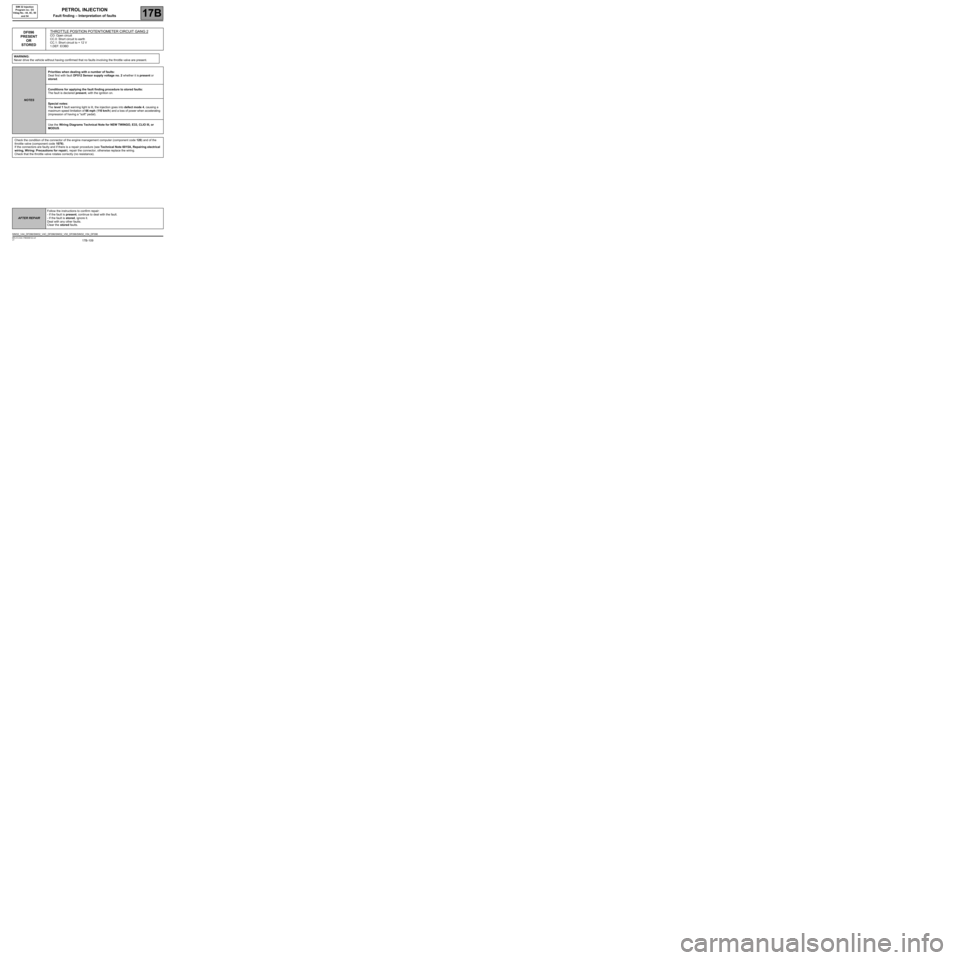
17B-109V7 MR-413-X44-17B000$132.mif
PETROL INJECTION
Fault finding – Interpretation of faults17B
SIM 32 Injection
Program no.: D3
Vdiag No.: 44, 4C, 50
and 54
DF096
PRESENT
OR
STOREDTHROTTLE POSITION POTENTIOMETER CIRCUIT GANG 2CO: Open circuit
CC.0: Short circuit to earth
CC.1: Short circuit to + 12 V
1.DEF: EOBD
WARNING:
Never drive the vehicle without having confirmed that no faults involving the throttle valve are present.
NOTESPriorities when dealing with a number of faults:
Deal first with fault DF012 Sensor supply voltage no. 2 whether it is present or
stored.
Conditions for applying the fault finding procedure to stored faults:
The fault is declared present, with the ignition on.
Special notes:
The level 1 fault warning light is lit, the injection goes into defect mode 4, causing a
maximum speed limitation of 66 mph (110 km/h) and a loss of power when accelerating
(impression of having a "soft" pedal).
Use the Wiring Diagrams Technical Note for NEW TWINGO, E33, CLIO III, or
MODUS.
Check the condition of the connector of the engine management computer (component code 120) and of the
throttle valve (component code 1076).
If the connectors are faulty and if there is a repair procedure (see Technical Note 6015A, Repairing electrical
wiring, Wiring: Precautions for repair), repair the connector, otherwise replace the wiring.
Check that the throttle valve rotates correctly (no resistance).
SIM32_V44_DF096/SIM32_V4C_DF096/SIM32_V50_DF096/SIM32_V54_DF096
AFTER REPAIRFollow the instructions to confirm repair:
- If the fault is present, continue to deal with the fault.
- If the fault is stored, ignore it.
Deal with any other faults.
Clear the stored faults.
Page 117 of 348
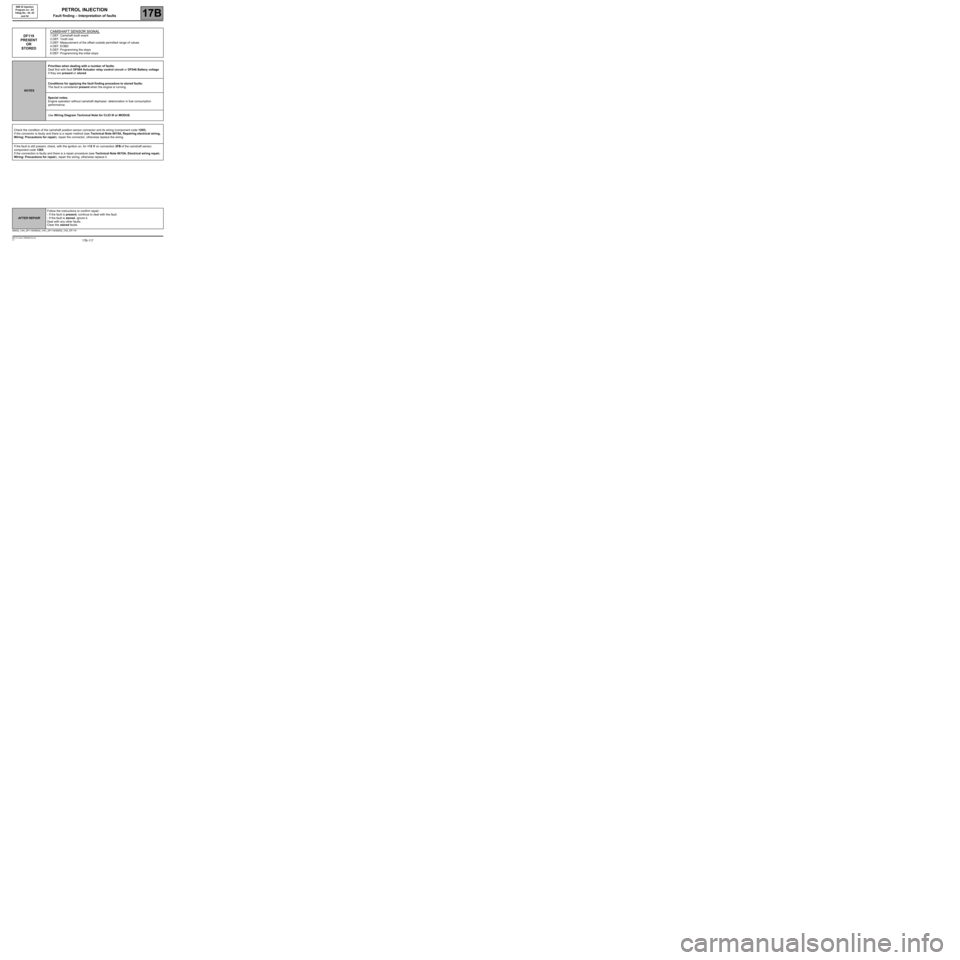
17B-117V7 MR-413-X44-17B000$132.mif
PETROL INJECTION
Fault finding – Interpretation of faults17B
SIM 32 Injection
Program no.: D3
Vdiag No.: 44, 4C
and 54
DF119
PRESENT
OR
STOREDCAMSHAFT SENSOR SIGNAL1.DEF: Camshaft tooth event
2.DEF: Tooth lost
3.DEF: Measurement of the offset outside permitted range of values
4.DEF: EOBD
5.DEF: Programming the stops
6.DEF: Programming the initial stops
NOTESPriorities when dealing with a number of faults:
Deal first with fault DF084 Actuator relay control circuit or DF046 Battery voltage
if they are present or stored.
Conditions for applying the fault finding procedure to stored faults:
The fault is considered present when the engine is running.
Special notes:
Engine operation without camshaft dephaser: deterioration in fuel consumption
performance.
Use Wiring Diagram Technical Note for CLIO III or MODUS.
Check the condition of the camshaft position sensor connector and its wiring (component code 1265).
If the connector is faulty and there is a repair method (see Technical Note 6015A, Repairing electrical wiring,
Wiring: Precautions for repair), repair the connector, otherwise replace the wiring.
If the fault is still present, check, with the ignition on, for +12 V on connection 3FB of the camshaft sensor,
component code 1265.
If the connection is faulty and there is a repair procedure (see Technical Note 6015A, Electrical wiring repair,
Wiring: Precautions for repair), repair the wiring, otherwise replace it.
SIM32_V44_DF119/SIM32_V4C_DF119/SIM32_V54_DF119
AFTER REPAIRFollow the instructions to confirm repair:
- If the fault is present, continue to deal with the fault.
- If the fault is stored, ignore it.
Deal with any other faults.
Clear the stored faults.
Page 118 of 348
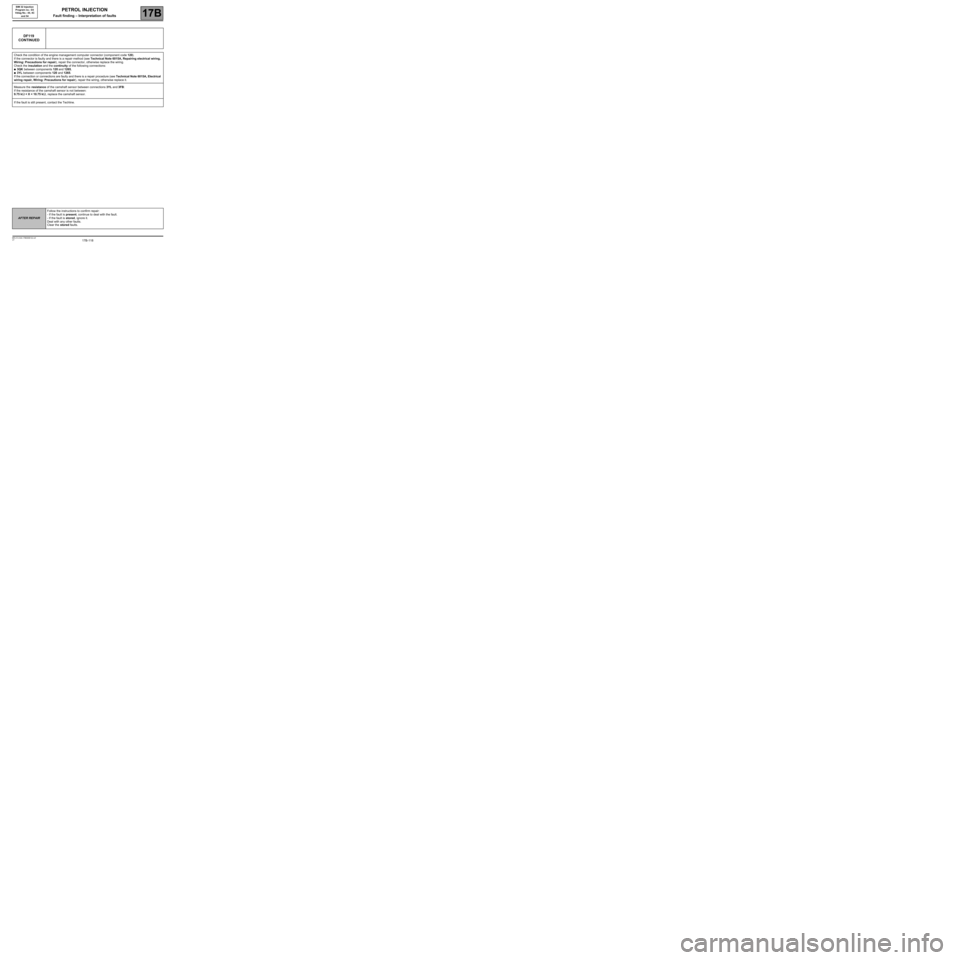
17B-118V7 MR-413-X44-17B000$132.mif
PETROL INJECTION
Fault finding – Interpretation of faults17B
SIM 32 Injection
Program no.: D3
Vdiag No.: 44, 4C
and 54
DF119
CONTINUED
Check the condition of the engine management computer connector (component code 120).
If the connector is faulty and there is a repair method (see Technical Note 6015A, Repairing electrical wiring,
Wiring: Precautions for repair), repair the connector, otherwise replace the wiring.
Check the insulation and the continuity of the following connections:
●3QK between components 120 and 1265,
●3YL between components 120 and 1265.
If the connection or connections are faulty and there is a repair procedure (see Technical Note 6015A, Electrical
wiring repair, Wiring: Precautions for repair), repair the wiring, otherwise replace it.
Measure the resistance of the camshaft sensor between connections 3YL and 3FB:
If the resistance of the camshaft sensor is not between:
9.75 k
Ω < X < 10.75 kΩ, replace the camshaft sensor.
If the fault is still present, contact the Techline.
AFTER REPAIRFollow the instructions to confirm repair:
- If the fault is present, continue to deal with the fault.
- If the fault is stored, ignore it.
Deal with any other faults.
Clear the stored faults.
Page 123 of 348
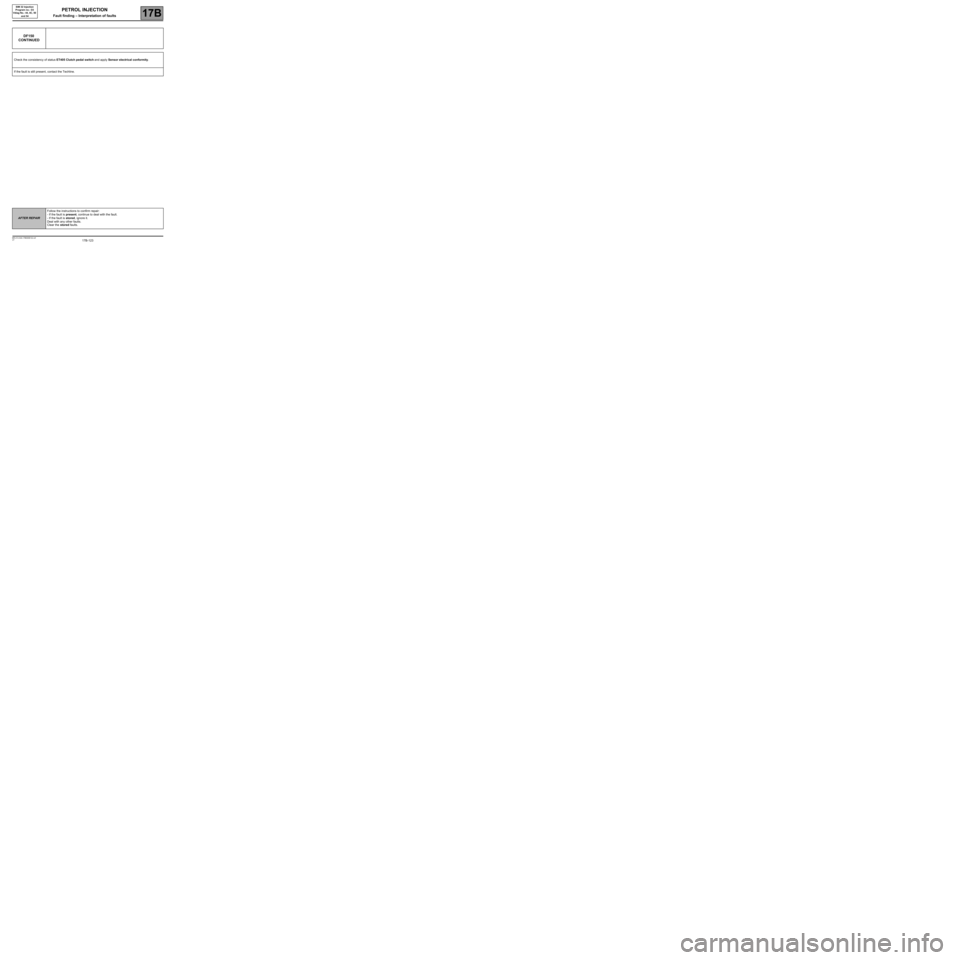
17B-123V7 MR-413-X44-17B000$132.mif
PETROL INJECTION
Fault finding – Interpretation of faults17B
SIM 32 Injection
Program no.: D3
Vdiag No.: 44, 4C, 50
and 54
DF150
CONTINUED
Check the consistency of status ET405 Clutch pedal switch and apply Sensor electrical conformity.
If the fault is still present, contact the Techline.
AFTER REPAIRFollow the instructions to confirm repair:
- If the fault is present, continue to deal with the fault.
- If the fault is stored, ignore it.
Deal with any other faults.
Clear the stored faults.
Page 124 of 348
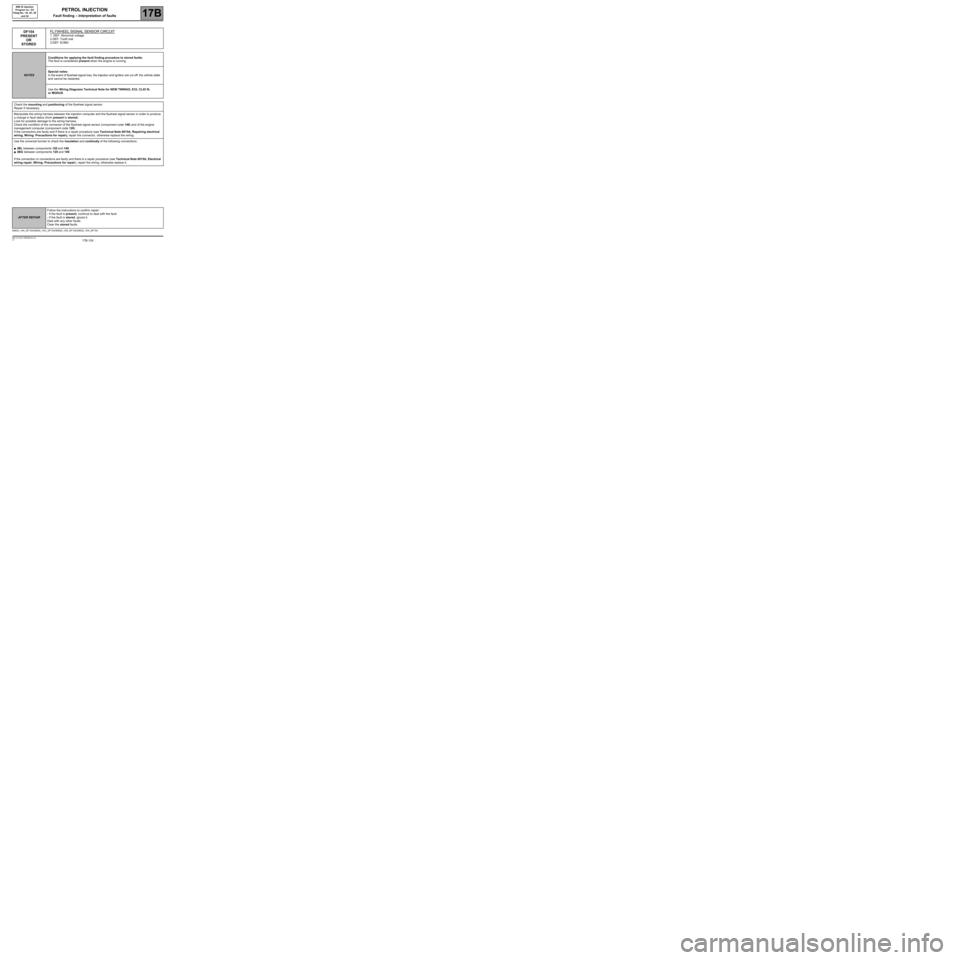
17B-124V7 MR-413-X44-17B000$132.mif
PETROL INJECTION
Fault finding – Interpretation of faults17B
SIM 32 Injection
Program no.: D3
Vdiag No.: 44, 4C, 50
and 54
DF154
PRESENT
OR
STOREDFLYWHEEL SIGNAL SENSOR CIRCUIT
1. DEF: Abnormal voltage
2.DEF: Tooth lost
3.DEF: EOBD
NOTESConditions for applying the fault finding procedure to stored faults:
The fault is considered present when the engine is running.
Special notes:
In the event of flywheel signal loss, the injection and ignition are cut off: the vehicle stalls
and cannot be restarted.
Use the Wiring Diagrams Technical Note for NEW TWINGO, E33, CLIO III,
or MODUS.
Check the mounting and positioning of the flywheel signal sensor.
Repair if necessary.
Manipulate the wiring harness between the injection computer and the flywheel signal sensor in order to produce
a change in fault status (from present to stored).
Look for possible damage to the wiring harness.
Check the condition of the connector of the flywheel signal sensor (component code 149) and of the engine
management computer (component code 120).
If the connectors are faulty and if there is a repair procedure (see Technical Note 6015A, Repairing electrical
wiring, Wiring: Precautions for repair), repair the connector, otherwise replace the wiring.
Use the universal bornier to check the insulation and continuity of the following connections:
●3BL between components 120 and 149,
●3BG between components 120 and 149.
If the connection or connections are faulty and there is a repair procedure (see Technical Note 6015A, Electrical
wiring repair, Wiring: Precautions for repair), repair the wiring, otherwise replace it.
SIM32_V44_DF154/SIM32_V4C_DF154/SIM32_V50_DF154/SIM32_V54_DF154
AFTER REPAIRFollow the instructions to confirm repair:
- If the fault is present, continue to deal with the fault.
- If the fault is stored, ignore it.
Deal with any other faults.
Clear the stored faults.